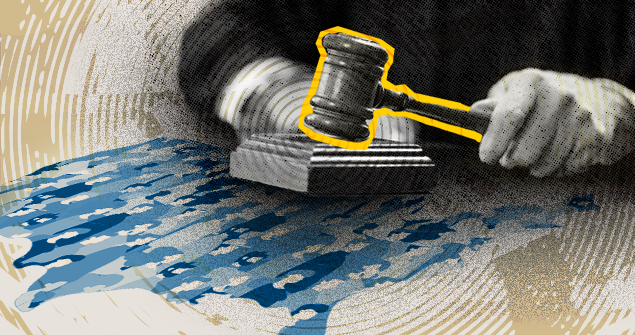Tamika Montgomery-Reeves made history last fall when she was confirmed as the first Black justice on the Delaware Supreme Court. It was a small step toward improving diversity on state supreme courts nationwide, but it also highlights a glaring problem.
Her appointment is unusual, yet it shouldn’t be — especially in a state where 23 percent of the population is Black. A lack of diversity among judges undermines public faith in the justice system, and it limits the perspectives available to inform judicial decisions.
In July 2019, the Brennan Center released State Supreme Court Diversity, a report detailing the vast racial, ethnic, and gender disparities on state high courts across the country. Drawing on nearly 60 years of data, the study examined the factors that have contributed to this serious issue, including substantial racial disparities in the outcomes of judicial elections.
Now we’re releasing new data updating the report with the current composition of state supreme courts as of early February.
Racial, ethnic, and gender disparities persist
In the past nine months there’s been little movement in the overall demographic composition of state high courts, which rarely look anything like the increasingly diverse American population.
Since May 2019, when we last collected data, there have been 19 openings on state supreme courts across the country. Fourteen of these vacancies have since been filled, two via elections and twelve via appointments.
Strikingly, white men continue to be overrepresented: half of these 14 seats were filled by white men, including in four states where people of color make up over 30 percent of the population. Of the other seven seats, four were filled by white women, one by a Black woman, and two by a male and female Native American justice, respectively.
Currently, 23 states have an all-white state supreme court bench, including 12 states where people of color are at least 20 percent of the population. And while people of color make up nearly 40 percent of the U.S. population, only 15.5 percent of state supreme court seats are held by people of color, up 0.5 percentage points from last year.
Only six states — California, Connecticut, Minnesota, North Carolina, Oregon, and Washington — have a supreme court bench where the percentage of people of color is higher than their representation in the state’s population as a whole, excluding states with vacant seats. (For a full state-by-state breakdown, see our update page.) Even more states fall short when data is disaggregated. For example, New York State has the second largest Asian population in the United States but has never had an Asian justice on its highest court.
With respect to gender diversity, 6 out of 14 new justices were women, and overall five states have more women on their high courts than they did last year, while two states have fewer women.
Women now hold 37 percent of state supreme court seats, up 1 percentage point from last year. Fifteen states currently have one or fewer female justices on their high courts.
Florida is a standout — and not in a good way. With two vacancies on its seven-member high court, the state currently has no female justices. The state’s last female high court justice, Barbara Lagoa, left the state bench in September after being appointed to a federal appeals court. Lagoa, who is Cuban American, was also one of three people of color on Florida’s high court bench. Of the five men who currently sit on the Florida Supreme Court, two are Latino and three are white.
Pockets of progress
Two states did see historic appointments since the release of our report. The first was the appointment of Justice Montgomery-Reeves in Delaware. Not only is she the state’s first Black justice, she is also only the second woman to sit on the state’s high court bench. With her appointment, there are now 17 states that have never had a Black justice (many of which have small Black populations).
In Washington, Raquel Montoya-Lewis became the first Native American person to ascend to the state’s highest court. Notably, while Washington uses judicial elections, all three of the justices of color currently sitting on its high court were initially appointed by the governor to fill an interim vacancy. By contrast, four of the six white justices first reached the bench through statewide election. This is consistent with the finding in our report that judicial elections have rarely been a path to the supreme court bench for people of color — and is one reason why we recommend appointments instead of elections for state supreme court seats.
Another noteworthy development came in Oklahoma, where Dustin Rowe, a Native American, was named to the Oklahoma Supreme Court. The two appointments in Washington and Oklahoma tripled the number of Native American state supreme court justice in the entire country, since before there was only one — Justice Anne McKeig of the Minnesota Supreme Court.
These advancements come as Native Americans continue to be underrepresented in the legal profession as a whole. A 2015 study by the National Native American Bar Association detailed the experiences of Native American attorneys, including ways that discrimination and a dearth of support systems have posed hurdles to professional advancement. Our report detailed how related obstacles have contributed to the lack of representation on state supreme courts for other people of color as well as women.
More must be done to achieve diversity on the bench, including increasing professional opportunities for underrepresented groups and addressing racial disparities in judicial elections. To have a justice system that realizes its name, we need courts that reflect an increasingly diverse America.






